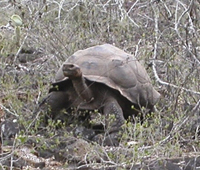
Unnamed taxon of Galapagos Tortoise Almost 150 years after Charles Darwin proposed a mechanism for biological evolution, previously unrecognized diversity has been discovered among the giant tortoises of the Galápagos, Geochelone nigra, whose distinctiveness was an inspiration in formulating the theory of natural selection.
The new taxon (species or sub-species) of Galápagos tortoise was characterized by a team of scientists led by Michael Russello, Adalgisa Caccone and Jeffrey Powell in the Department of Ecology and Evolutionary Biology at Yale. Conservation of its habitat is an immediate concern because the human population on the island of Santa Cruz is growing rapidly. The team emphasized the importance of accurate taxa identification for effective conservation policy and preservation of genetic diversity in a recent report in Biology Letters published by the Royal Society of London.
The current tortoise populations on the island of Santa Cruz, long believed to comprise a single taxon, are in fact, three genetically distinct lineages that are yet to be formally named.
While visible characteristics, like the shapes of their shells, were the basis for previous classification of the tortoises, this research team used a variety of molecular genetic and analytical tools including mitochondrial DNA analysis from extinct taxa. The comprehensive study of these tortoises throughout Galápagos made their discovery possible.
Currently 11 of the recognized 15 taxa of tortoise are living and continue to be endangered throughout the Galápagos. Only 2,000 – 4,000 individual tortoises remain on Santa Cruz, and there may be as few as 100 individuals of the new taxon.
"It is ironic that while Santa Cruz has the largest population of tortoises, it also has the largest human population -- projected to double in the next eight years -- which is their greatest source of endangerment," said Russello. "Since accurate taxonomy is crucial for effective conservation policy, these results have fundamental importance for preserving the genetic and taxonomic diversity of these historically-significant reptiles."
Collaborators included Scott Glaberman at Yale, James P. Gibbs at the State University of New York (Syracuse), and Cruz Marquez at the Charles Darwin Research station, Santa Cruz, Ecuador. The study was funded through the ECOSAVE project of the Yale Institute for Biospheric Studies and a National Geographic grant.
Source : Yale University
 Print Article
Print Article Mail to a Friend
Mail to a Friend
